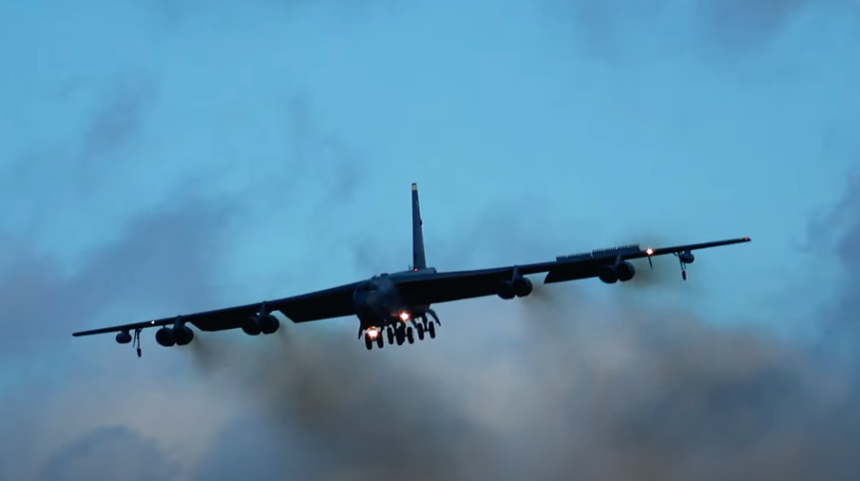Impressive footage shows the BUFFs landing in strong winds after mission over Sweden earlier today.
With wind gusts at 122mph, the fastest on record in England, Storm Eunice wreaked havoc across the UK leaving thousands of homes without power and forcing businesses to shut on Friday Feb. 18, 2022. The UK Met Office expanded the “danger-to-life” weather alert before Eunice tore down rooftops and trees, crushed cars disrupted air travel causing the cancellation of many flights.
Despite the hurricane-strength winds, two B-52 Stratofortress bombers deployed to RAF Fairford, UK, as part of BTF (Bomber Task Force) 22-2 carried out a round-trip mission that brought them over Scandinavia.
Flying as ZEUS51 and ZEUS52, the two BUFFs, serials #61-0003 and 61-0018, could be tracked online via Mode-S as they flew northeast bound to Sweden via Denmark.
The two United States Air Force Boeings B-52H Stratofortress from 🇬🇧RAF Fairford are currently circling over southern 🇸🇪Sweden, showing very pretty tracks. Changing altitude regularly, occasionally descending below 6,000 ft.
🇺🇸61-0003 #ZEUS51 #AE589A
🇺🇸61-0018 #ZEUS52 #AE58A7 pic.twitter.com/TYRWXn4SZ6
— Gerjon | חריון (@Gerjon_) February 18, 2022
Over southern Sweden, the U.S. strategic bombers integrated with the Swedish Air Force JAS 39C Gripens before heading back and RTB (Return To Base).
A JAS 39C #Gripen pair loaded with with IRIS-T, METEOR and AMRAAM missiles escorting USAF B-52. Photo: Försvarsmakten, Feb 18, 2022. #FighterFriday pic.twitter.com/aSqtM68foy
— Gripen News (@GripenNews) February 18, 2022
Despite the strong winds, the B-52s were able to land at RAF Fairford. However, their final approach to the base in Gloucestershire was far from stable, with pilots making continuous corrections to maintain the heavy bombers aligned with the runway. Our friend @Saint1Mil filmed the arrival of the two Stratofortresses.
“Although the winds were very strong they were head on with little crosswind,” he comments. “The approaches were very slow, almost appearing to hover at one point!”
Take a look.
One detail worth of note about the B-52 is the bomber’s steerable dual-bicycle landing gear which allows the crew to “crab” the airframe by 20 degrees, i.e. to keep the gear along the runway while the fuselage is pointing up to 20 degrees off the runway centerline.
In fact, the B-52 was designed in such a way the landing gear can be set up to 20 degrees left to right of centerline for both takeoff and landing.
This is what we wrote in a previous article we published here at The Aviationist:
As explained by NASA (that has been a BUFF operator) on its website, “the landing gear of the B-52 is of the same bicycle arrangement as employed on the B-47 but has four two-wheel bogies instead of the two bogies used on the earlier aircraft. As compared with their location on the B-47, the outrigger wheels are positioned much nearer the wingtip on the B-52. An interesting feature of the B-52 landing gear greatly eases the problems posed by crosswind landings. Both the front and rear bogies can be set at angles of as much as 20° to either side of the straight-ahead position. In a crosswind landing, consequently, the aircraft can be headed directly into the wind while rolling down a runway not aligned with the wind.”
The reason for this peculiar feature is primarily due to the structure of the airframe that features a very long and relatively slender fuselage with a big tail and massive high wings that bear the weight of the aircraft. As a consequence of such design, the aircraft is slow to react to pilot inputs on the flight control surfaces, especially at low altitude and speed. Moreover, the wings are so large that the typical approach in crosswind [that is normally flown applying a Wind Correction Angle (WCA), hence “crabbing” the plane to align nose and tail with the wind direction to counter the drifting effect of side winds and “de-crab” once the main landing gear touches the ground (or shortly before)], is simply not possible.









